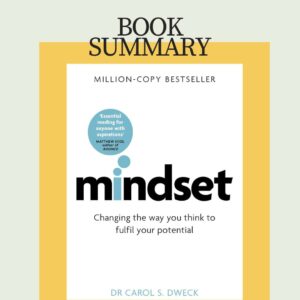Mindset book summary
Welcome to the insightful journey of uncovering the transformative power of mindset through the prolific work of Carol S. Dweck. In this comprehensive summary, we delve into the core concepts and profound impact of the book “Mindset”.
Discover the intellectual force behind the bestseller as we introduce you to Carol S. Dweck, a distinguished psychologist renowned for her groundbreaking research on human motivation and mindset. Here’s what sets her apart:
Credibility: Carol S. Dweck holds a Ph.D. in Psychology from Stanford University and serves as a pioneering researcher in the field of personality, social psychology, and developmental psychology.
Research Focus: Her primary focus lies in understanding the role of beliefs and thoughts in shaping human behavior and achievement.
The Concept: Mindset: Diving into the very essence of her work, Dweck’s concept of “Mindset” highlights the fundamental difference between a growth mindset and a fixed mindset.

Table of Contents
The Premise of the Book
Unravel the profound insights conveyed in the book Mindset by exploring the contrasting ideologies of a growth mindset and a fixed mindset:
Growth vs. Fixed Mindset Overview: Understand the core differences between these mindsets and how they influence one’s approach towards challenges and opportunities.
The Impact of Both Mindsets: Delve into the psychological impacts of nurturing a growth mindset versus being confined by a fixed mindset.
Importance of Growth Mindset: Discover why embracing a growth mindset is paramount for personal development and achieving success in various facets of life.
By setting the stage with these foundational insights, we pave the way for a deeper exploration into the transformative power of mindset as elucidated in Carol S. Dweck’s enriching narrative.
Mindset Book Summary: Deep Dive into Book Content and its Application
Fixed Mindset Interrogation
A fixed mindset is a belief that one’s abilities, intelligence, and talents are static qualities that cannot be changed. Let’s delve into the characteristics of a fixed mindset and explore its implications.
Characteristics of a Fixed Mindset:
Individuals with a fixed mindset tend to believe that their abilities are innate and cannot be developed.
They avoid challenges, fearing failure would reflect their lack of inherent talent.
Feedback is often perceived as personal criticism, leading to defensiveness and resistance to change.
Barriers of a Fixed Mindset:
Fixed mindset individuals are less likely to take risks or explore new opportunities due to their fear of failure.
They may plateau in their personal and professional growth as they are reluctant to step out of their comfort zones.
Real-life Examples:
Consider the story of a student who believed they were not naturally gifted in mathematics and thus stopped trying. This fixed mindset hindered their academic progress.
A professional who avoids leadership roles for fear of not meeting expectations due to their fixed beliefs about their capabilities.
Growth Mindset Grasp
In contrast, a growth mindset is the belief that intelligence and abilities can be developed through dedication, effort, and hard work. Let’s explore the essence of a growth mindset and practical ways to cultivate it.
The Nature of a Growth Mindset:
Individuals with a growth mindset embrace challenges as opportunities to learn and grow.
They view failures as valuable lessons and setbacks as temporary obstacles to overcome through perseverance.
Techniques to Develop a Growth Mindset:
Engage in continuous learning by seeking out new experiences and knowledge.
Embrace challenges and setbacks as opportunities for personal growth and skill development.
Cultivate a positive attitude towards learning and improvement.
Real-world Applications:
A student with a growth mindset sees setbacks in academics as opportunities to improve and seeks additional support to enhance their understanding.
A professional with a growth mindset views constructive feedback as a means to enhance their skills and performance.
Transition from Fixed to Growth Mindset
Moving from a fixed mindset to a growth mindset requires conscious effort and a willingness to challenge deeply ingrained beliefs about ability and intelligence. Let’s explore strategies for shifting mindsets and the transformative impact it can have.
Strategies for Shifting Mindsets:
Embrace challenges and view failures as learning opportunities rather than personal shortcomings.
Cultivate a passion for learning and continuous improvement.
Surround yourself with individuals who embody a growth mindset to foster a supportive environment.
Examples of Transformation:
An individual who previously avoided public speaking due to a fear of failure begins to view it as a skill to develop through practice and feedback.
A team leader shifts from micromanaging to empowering team members, fostering a culture of innovation and collaboration.
Impact on Personal and Professional Life:
Transitioning from a fixed to a growth mindset can lead to increased resilience, adaptability, and a willingness to take on new challenges.
In the professional realm, a growth mindset can enhance leadership capabilities, foster creativity, and promote a culture of continuous improvement.
Frequently Asked Questions (FAQs) About the Mindset Book Summary
What is the key concept of the Mindset book by Carol S. Dweck?
The key concept of the Mindset book revolves around the idea of two main mindsets: the fixed mindset, where individuals believe their abilities are set in stone, and the growth mindset, where individuals believe they can develop and improve their abilities through effort and learning.
How can one transition from a fixed mindset to a growth mindset?
Transitioning from a fixed mindset to a growth mindset involves recognizing and challenging fixed beliefs, embracing challenges and setbacks as opportunities for growth, learning from criticism, and cultivating a passion for learning and resilience.
What are some real-life examples of individuals with fixed mindsets and growth mindsets?
Real-life examples of a fixed mindset include individuals who avoid challenges for fear of failure, blame others for their setbacks, and feel threatened by the success of others. On the other hand, examples of a growth mindset include individuals who embrace challenges, persist in the face of obstacles, and see failure as an opportunity to learn and grow.
How does the growth mindset impact personal and professional life?
The growth mindset can have a profound impact on personal and professional life by fostering resilience, a desire for continuous improvement, the ability to adapt to change, and a willingness to take risks in pursuit of goals and success.
What criticisms have been raised about Carol S. Dweck’s thesis in the Mindset book?
Some criticisms of Dweck’s thesis revolve around concerns about oversimplification of complex human behavior, lack of empirical evidence in certain areas, and the potential for the concept of mindset to be misinterpreted or misapplied.
Conculsion
In conclusion, the Mindset book by Carol S. Dweck offers valuable insights into the power of mindset in shaping success and personal growth. By understanding the differences between fixed and growth mindsets, individuals can learn to embrace challenges, cultivate resilience, and unlock their full potential. Through practical strategies and real-world examples, this book provides a roadmap for mindset transformation and empowers readers to adopt a growth-oriented approach to life. Whether in sports, education, relationships, or professional endeavors, the principles outlined in the Mindset book can inspire meaningful change and foster a mindset of continuous learning and improvement.




